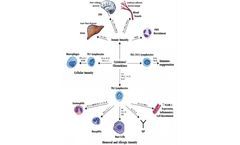Vascular Endothelial Growth Factor Articles & Analysis
10 articles found
Luminex growth factor assays utilize the same bead-based multiplex technology to simultaneously analyze multiple growth factors. This streamlined approach is essential in identifying dysregulated growth factor signaling in diseases like cancer or fibrosis. For example, vascular ...
Some of the primary classes include interleukins (IL), interferons (IFN), tumor necrosis factors (TNF), colony-stimulating factors (CSF), chemokines, and growth factors (GF). ...
Cytokines represent a class of small protein molecules that exhibit diverse biological activities. These molecules are synthesized and secreted primarily by immune cells (including monocytes, macrophages, T cells, B cells, and NK cells) as well as certain non-immune cells (such as endothelial cells, epidermal cells, and fibroblasts) upon specific stimulation. Cytokines play pivotal roles in ...
Promote angiogenesis and increase local blood supply Hair follicle growth relies on the vascular network of the hair papilla to supply nutrients. Vascular endothelial growth factor (VEGF) is a marker of angiogenesis. ...
About VEGF Vascular Endothelial Growth Factor (VEGF) is a highly biologically active functional glycoprotein. It is a specific and potent mitogen for endothelial cells, playing a role in their proliferation, migration, and lumen formation. VEGF is involved in angiogenesis and increases capillary permeability. It ...
Pembrolizumab is a class of immunotherapy drugs called immune checkpoint inhibitors (ICIs), while ramucirumab is a vascular endothelial growth factor receptor 2 (VEGFR-2) inhibitor, a class of drugs that block the enzyme drug. ...
The corresponding author of this article is Harvard Medical School Investigator Mark Cobbold, whose team focuses on the development of new immunotherapies, having previously investigated the combination of anti-PD-1 and anti-vascular endothelial growth factor receptor 2 inhibitors in liver cancer, among other things. ...
More than 200 types of human cytokines have been identified, which can be generally classified into interleukins, interferons, tumor necrosis factors, colony-stimulating factors, chemokines, growth factors, etc. according to their structure as well as function. ...
Lymphatic vessels play an important role in the regulation of tissue fluid balance, immune responses, and fat adsorption and are involved in diseases including lymphedema and tumor metastasis. Vascular endothelial growth factor (VEGF) receptor 3 (VEGFR-3) is necessary for development of the blood vasculature during early ...
The resemblance of NP protein of EBOV to vascular endothelial growth factor and its receptor, which play a key role in the regulation of vascular permeability, was identified. ...







